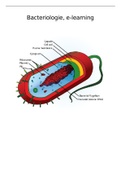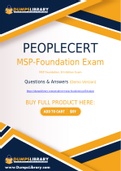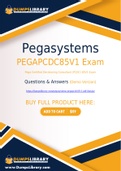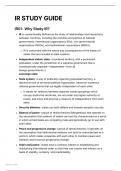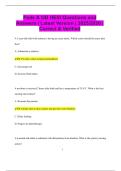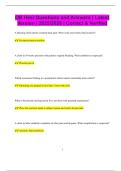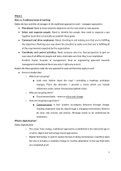“Microben” samenvatting
Microben -> Hamoen: INTRO
Planten ondervinden Pathogenen, grootste problemen door schimmels
Bacteriële ziekten
Longontsteking -> Streptococcus Pneumoniae
Tuberculose -> Mycobacterium tuberculosis
Voedselvergiftiging -> Salmonella Typhimurium
Escherichia Coli
Maagzweer -> Helicobacter pylori
Gonorroe -> Neisseria Gonorrhoeae
Veteranenziekte -> Legionella Pneumophila
Hersenvliesontsteking -> Haemophilus influenzae
Miltvuur -> Bacillus Anthracis
Schimmels niet echt gevaarlijk voor mens, tenzij ze leiden aan immuunproblemen
Eukaryote pathogenen (belangrijkst):
Protozoa (parasieten) -> bijv Malaria
Slaapziekte
Tobacco mosaic disease -> virus, want valt niet weg te filteren
Virusinfecties bij mensen: hepatitis, polio, mazelen
Pasteur: vaccinatie uitgewerkt
Immunisatie: de stimulatie van een immuunrespons door inoculatie met een pathog.
Goede kanten microben: eten & drinken, stikstoffixatie
Symbiose: Kortsmossen, microbioom
Essentiële rol microben: stikstoffixatie
Nutriëntencyclus
Productie enzymen
Vitaminen -> wasmiddelen
Biofules
Antibiotica (peniciline) vaak van bacteriën
Virussen kunnen nuttig zijn
Bacteriophagen houden bacteriën onder controle
Moleculaire biologische technieken
Restrictie-enzymen & Crispr Cas
Gebasseerd op systemen uit bacteriofagen
,Microben -> Hammoen: INHOUDELIJK
Bacteriële cel
Bekijken dmv lichtmicroscoop -> kleuring dmv gram stain (pos/neg)
Phase-contrast microscopy (fluophore)
Immunofluorescentie -> Green fluorent protein koppelen aan een eiwit zodat het gevolgd
kan worden (of de expressie gevolgd kan worden)
Fluorescentie microsopie
Electron microscopy -> TEM (doorsnede) & SEM (oppervlakte)
Cryo = fixeren van samples (hoge resolutie, dus eiwitstructuur in 3D te tekenen)
Toegepast in electron cryomicroscopy/ - cryo tomography
Magnetotaxis = Bacteriën naar een pool dmv magnetisch veld
Cell envelope: celwand + celmembraan
Bepaalt de vorm van een bacterie
Bacteriën hebben GEEN CHOLESTEROL, maar in sommigen wordt deze functie overgenomen
door hopanoids
Celwand: Peptidoglycan
Glucnac polymeer: suiker, 5/6 peptiden (vormen crosslinks)
D en niet L want L matcht goed aan proteases die de celwand afbreken. D-aminozuren
vormen dus bescherming
Gram pos: hele dikke celwand
Dikke laag peptidoglycan
Gram neg: tussen buiten- & binnenmembraan een laag van peptidoglycan (sterk periplasma)
Buitenmembraan beschermt tegen antibiotica, porines voor passage (lipide
polysaccharide, LPS)
Dunne laag peptidoglycan
Capsule (bijv LPS) = lange suikermoleculen die buitenlaag beschermen, zowel bij pos als neg
Zorgt dat phagocytose niet goed werkt
S-layer aan buitenkant (regelmatige rangschikking)
Bestaat uit eiwitten
Gram positief
Bacteriën zonder celwand
Voortbewegen als een soort slak
Hebben (semi)stabiele omgeving nodig
Niet te verwijderen met normaal/ grof filteren
Mycoplasma -> veroorzaakt pneumonia en meningitis
,Cytoskelet: 3 elementen
Fts Z -> vormt ring die fungeert als soort kapstok
MreB -> actinehomoloog (peptidoglycan synthese) vormt polymeren aan de
buitenkant van het membraan
CreS -> vormt polymeer dat zorgt voor de kromme vorm vd bacterie
Celdeling: FtsZ zorgt voor splitsing
Structuren, gespecialiseerd
Thylakoids -> gevouwde intracellulaire membranen met rol in fotosynthese
Carboxysomen -> CO2 fixatie
Gas vesicles -> drijfvermogen aanpassen
Storage granules
Glycogeen, PHB voor energie
Zwavel voor oxidatie
Magnetosomen
Pili/ fimbrae -> attachment/ vastzetten
Sex pili: gebruikt in conjugatie
Flagella -> gebruikt om te zwemmen, na draaien 1 grote flagella gevormd
Lange buis bestaat uit flacheline
Rotor, motor aangedreven door protonenstroom
Kunnen (counter)clockwise draaien
“tumble” -> veranderen van richting
Bij clockwise
Bacteriële groei & ontwikkeling
Verschillende media waarin ze groeien
Complex (nutrient rich, poor defined), synthetic (precisely defined), enriched
(complex media with specific blood components, selective (favor the growth of one
organism)
LB, MG …
Defined minimal medium bevat alleen stoffen die een bacterie nodig heeft om te
groeien
Energiebronnen
Phototroph, chemotroph, lithotroph, organotroph
Autotroph, Heterotroph
Bij groei moet je te maken hebben met een reincultuur (pure cultuur)
OD600 (optische dichtheid)
Verschillende fasen voor groeicurve bacterie
Lag – log – stationary - death
Viable count -> colonies tellen
Verdunnen en dan terugrekenen
, Aantal fluorescente cellen meten
Tellen na labeling met GFP: Flow cytometry
FACS -> cell sorter op basis van fluorescentie
Binary fussion -> binaire deling
Growth cycle: bacteriën “poepen” elkaar uit
Generation time -> snelheid van deling
Batch culture
Continue culture -> verversing van het medium; dit bepaalt de groeisnelheid
Verdund door vers medium -> generation time omlaag
Generation time omlaag -> groeisnelheid omhoog
Verdunningssnelheid heeft invloed op verdubbelingssnelheid
Cellulaire differentiatie
Biofilm: (vast) oppervlak waarop kolonies leven
Pseudomonas ae rugginosa
Moeilijk te behandelen met antibiotica, want groeit langzaam
Sporen
Heterocysten -> in cyanobacteriën (cel die geen fotosynthese uitvoert, maar
stikstoffixatie, dus geen O2)
Luchthyfen
Streptomyces -> schimmel die hyfen vormt, maar prokaryoot is. Als
voedingsstoffen op zijn luchthyfen. Ook groot genoom -> veel antibiotica
Fruiting bodies -> bacteriën die naar elkaar toe migreren en soort sporen /
paddestoelen maken (genoom zo groot als gist)
Environmental challenges
Extremophiles -> extreme (omgevings)condities
Bijv. Antartica
Psychophilen (koud), Mesophilen (normaal), Thermophilen (warm) &
Hyperthermophilen (heel warm)
Barophilen -> micro-organismen die groeien onder grote druk
Halophilen -> micro-organismen die groeien bij hoge zoutconcentraties
Speciale ionpompen in membraan om Na+ weg te pompen
PH:
Neutralophiles -> pH 5-8
Acidophiles -> pH 0-5
Alkaliphiles -> pH 9-11
Oxygen crisis -> extinctie door zuurstof
Microben -> Hamoen: INTRO
Planten ondervinden Pathogenen, grootste problemen door schimmels
Bacteriële ziekten
Longontsteking -> Streptococcus Pneumoniae
Tuberculose -> Mycobacterium tuberculosis
Voedselvergiftiging -> Salmonella Typhimurium
Escherichia Coli
Maagzweer -> Helicobacter pylori
Gonorroe -> Neisseria Gonorrhoeae
Veteranenziekte -> Legionella Pneumophila
Hersenvliesontsteking -> Haemophilus influenzae
Miltvuur -> Bacillus Anthracis
Schimmels niet echt gevaarlijk voor mens, tenzij ze leiden aan immuunproblemen
Eukaryote pathogenen (belangrijkst):
Protozoa (parasieten) -> bijv Malaria
Slaapziekte
Tobacco mosaic disease -> virus, want valt niet weg te filteren
Virusinfecties bij mensen: hepatitis, polio, mazelen
Pasteur: vaccinatie uitgewerkt
Immunisatie: de stimulatie van een immuunrespons door inoculatie met een pathog.
Goede kanten microben: eten & drinken, stikstoffixatie
Symbiose: Kortsmossen, microbioom
Essentiële rol microben: stikstoffixatie
Nutriëntencyclus
Productie enzymen
Vitaminen -> wasmiddelen
Biofules
Antibiotica (peniciline) vaak van bacteriën
Virussen kunnen nuttig zijn
Bacteriophagen houden bacteriën onder controle
Moleculaire biologische technieken
Restrictie-enzymen & Crispr Cas
Gebasseerd op systemen uit bacteriofagen
,Microben -> Hammoen: INHOUDELIJK
Bacteriële cel
Bekijken dmv lichtmicroscoop -> kleuring dmv gram stain (pos/neg)
Phase-contrast microscopy (fluophore)
Immunofluorescentie -> Green fluorent protein koppelen aan een eiwit zodat het gevolgd
kan worden (of de expressie gevolgd kan worden)
Fluorescentie microsopie
Electron microscopy -> TEM (doorsnede) & SEM (oppervlakte)
Cryo = fixeren van samples (hoge resolutie, dus eiwitstructuur in 3D te tekenen)
Toegepast in electron cryomicroscopy/ - cryo tomography
Magnetotaxis = Bacteriën naar een pool dmv magnetisch veld
Cell envelope: celwand + celmembraan
Bepaalt de vorm van een bacterie
Bacteriën hebben GEEN CHOLESTEROL, maar in sommigen wordt deze functie overgenomen
door hopanoids
Celwand: Peptidoglycan
Glucnac polymeer: suiker, 5/6 peptiden (vormen crosslinks)
D en niet L want L matcht goed aan proteases die de celwand afbreken. D-aminozuren
vormen dus bescherming
Gram pos: hele dikke celwand
Dikke laag peptidoglycan
Gram neg: tussen buiten- & binnenmembraan een laag van peptidoglycan (sterk periplasma)
Buitenmembraan beschermt tegen antibiotica, porines voor passage (lipide
polysaccharide, LPS)
Dunne laag peptidoglycan
Capsule (bijv LPS) = lange suikermoleculen die buitenlaag beschermen, zowel bij pos als neg
Zorgt dat phagocytose niet goed werkt
S-layer aan buitenkant (regelmatige rangschikking)
Bestaat uit eiwitten
Gram positief
Bacteriën zonder celwand
Voortbewegen als een soort slak
Hebben (semi)stabiele omgeving nodig
Niet te verwijderen met normaal/ grof filteren
Mycoplasma -> veroorzaakt pneumonia en meningitis
,Cytoskelet: 3 elementen
Fts Z -> vormt ring die fungeert als soort kapstok
MreB -> actinehomoloog (peptidoglycan synthese) vormt polymeren aan de
buitenkant van het membraan
CreS -> vormt polymeer dat zorgt voor de kromme vorm vd bacterie
Celdeling: FtsZ zorgt voor splitsing
Structuren, gespecialiseerd
Thylakoids -> gevouwde intracellulaire membranen met rol in fotosynthese
Carboxysomen -> CO2 fixatie
Gas vesicles -> drijfvermogen aanpassen
Storage granules
Glycogeen, PHB voor energie
Zwavel voor oxidatie
Magnetosomen
Pili/ fimbrae -> attachment/ vastzetten
Sex pili: gebruikt in conjugatie
Flagella -> gebruikt om te zwemmen, na draaien 1 grote flagella gevormd
Lange buis bestaat uit flacheline
Rotor, motor aangedreven door protonenstroom
Kunnen (counter)clockwise draaien
“tumble” -> veranderen van richting
Bij clockwise
Bacteriële groei & ontwikkeling
Verschillende media waarin ze groeien
Complex (nutrient rich, poor defined), synthetic (precisely defined), enriched
(complex media with specific blood components, selective (favor the growth of one
organism)
LB, MG …
Defined minimal medium bevat alleen stoffen die een bacterie nodig heeft om te
groeien
Energiebronnen
Phototroph, chemotroph, lithotroph, organotroph
Autotroph, Heterotroph
Bij groei moet je te maken hebben met een reincultuur (pure cultuur)
OD600 (optische dichtheid)
Verschillende fasen voor groeicurve bacterie
Lag – log – stationary - death
Viable count -> colonies tellen
Verdunnen en dan terugrekenen
, Aantal fluorescente cellen meten
Tellen na labeling met GFP: Flow cytometry
FACS -> cell sorter op basis van fluorescentie
Binary fussion -> binaire deling
Growth cycle: bacteriën “poepen” elkaar uit
Generation time -> snelheid van deling
Batch culture
Continue culture -> verversing van het medium; dit bepaalt de groeisnelheid
Verdund door vers medium -> generation time omlaag
Generation time omlaag -> groeisnelheid omhoog
Verdunningssnelheid heeft invloed op verdubbelingssnelheid
Cellulaire differentiatie
Biofilm: (vast) oppervlak waarop kolonies leven
Pseudomonas ae rugginosa
Moeilijk te behandelen met antibiotica, want groeit langzaam
Sporen
Heterocysten -> in cyanobacteriën (cel die geen fotosynthese uitvoert, maar
stikstoffixatie, dus geen O2)
Luchthyfen
Streptomyces -> schimmel die hyfen vormt, maar prokaryoot is. Als
voedingsstoffen op zijn luchthyfen. Ook groot genoom -> veel antibiotica
Fruiting bodies -> bacteriën die naar elkaar toe migreren en soort sporen /
paddestoelen maken (genoom zo groot als gist)
Environmental challenges
Extremophiles -> extreme (omgevings)condities
Bijv. Antartica
Psychophilen (koud), Mesophilen (normaal), Thermophilen (warm) &
Hyperthermophilen (heel warm)
Barophilen -> micro-organismen die groeien onder grote druk
Halophilen -> micro-organismen die groeien bij hoge zoutconcentraties
Speciale ionpompen in membraan om Na+ weg te pompen
PH:
Neutralophiles -> pH 5-8
Acidophiles -> pH 0-5
Alkaliphiles -> pH 9-11
Oxygen crisis -> extinctie door zuurstof


